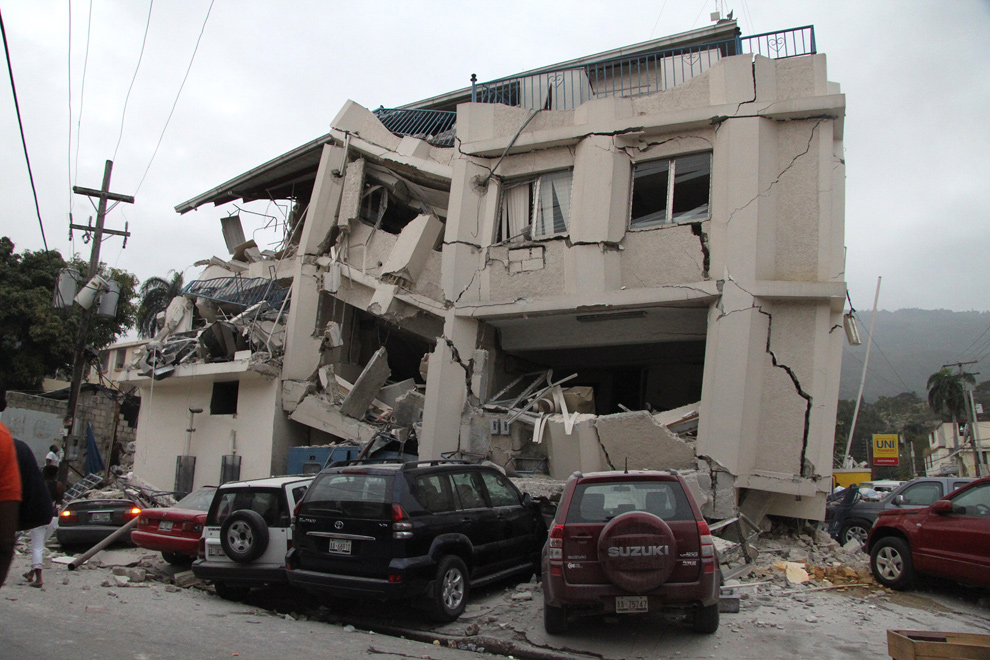Assigned Disaster: Earthquake
Team Members
Matthew Sinpraseuth
Shanny Lam
Christopher Tee
Hayley Sunhwa chung
Causes and Characteristics of Earthquakes
Highly Unpredictable and often occur suddenly without warning
50,000 occurring earthquakes every year around the globe
Earthquake prone areas are generally well identified and well known on the basis of geological features and past occurrences of earthquakes.
Shallow focus earthquakes are more common and are extremely damaging because of their close proximity to the surface.
Body waves (P and S waves) penetrate the body of the earth, vibrating fast.P waves traveling at about 6 km per hour, provide the initial jolt and cause buildings to vibrate in an up and down motion.S waves, traveling about 4 km per second in a movement similar to a rope snapped like a whip, cause a typically sharper jolt that vibrates structures from side to side and typically causes even greater damage.
Sources:
Causes & Characters of earthquakes
General Characters of earthquakes
What are the essential characteristics of Earthquake?
Image Source:
Earthquake features block diagram
Haiti Earthquake 2010.
12 January 2010, 16:53. 7.0 magnitude.
The epicenter of the quake was located 25km from the capital city of Haiti, Port-au-Prince. Aftershocks of the quake occurred for another 12 days, with magnitude recordings of at least 4.5. The exact number of fatalities is unknown, but ranged from 46 000-316 000. 3 million people were affected by the disaster, and according to the Haitian government, 250 000 residential, 30 000 commercial infrastructure and 80% of schools were critically damaged or destroyed.
General
Haiti has a population of 9 million people, with 80% of the population living under the poverty line. It is considered as the poorest country in the western hemisphere.
Aftermath
“In fact, “removing all the earthquake debris from the country would require at least 1,000 trucks working 24 hours a day for up to five years” (Herlinger). In addition to these building damages the ports in this nation’s capital were ruined by the collapse of several cranes. As a result supplies were not only lost but the entrance for aiding ships were temporarily inhibited. Haiti’s closest airport, Aeroport International Toussaint L’Ouverture, was also damaged thereby diverting planes bringing relief to other airports (Ivy). Finally, the few roads that were paved in Haiti were left cracked and flooded with cars damaged by the earthquake, making transportation in and out of Haiti nearly impossible.” source
As of 2012, two years after the disaster -
December 2011, IOM (International Organisation of Migration) approximated that 550 560 people still remained in the temporary homes.
Haiti was still struggling to rebuild their damaged structures. Due to the country’s existing poverty conditions prior to the earthquake, infrastructure and residential units were inadequate and insufficient in supply. This made recovery more difficult.
1.5 million people were displaced following the disaster - some have returned home, but a third of the amount still confide in the fugitive camps.
Images
Christchurch, New Zealand earthquake 2011
General info: locality, fatalities and aftermath
http://www.teara.govt.nz/en/historic-earthquakes/page-13
Date: Tuesday 22nd Feb 2011
Time: 12:51PM
Christchurch badly damaged by earthquake of 6.3 magnitude, killing 185 people and left several thousand injured. This particular earthquake is considered as the aftershock of a the earthquake that occurred 5 months earlier in September, 2010.
Majority of the fatalities (110) were from the collapse of two multi-storey office buildings. Falling bricks and masonry on streets killed 11 people. 6 died in two city buses crushed by crumbling walls. Rock cliffs behind houses collapsed and destroyed homes and killed 5.
Aftermath
Liquefaction
Definition: http://geology.com/usgs/liquefaction/
vibrations cause soil particles to to lose contact with one another. As a result soil behaves like liquid, has an inability to support weight and can flow down very gentle slops.
The eastern section of the city was built on a former swamp and the vibrations and shaking caused by the earthquake turned water saturated beneath the surface into sludge. This sludge squirted out of cracks in the ground and buried houses, streets and ruined its foundations and invaded the sewers.
A huge population (approx. 70,000) of Christchurch relocated due to the lack of services, extensive damage, inhabitable homes and continuing aftershocks. Children were taken out of school and re-enrolled into neighbouring cities.
Images
http://www.teara.govt.nz/en/photograph/32123/earthquake-damage
http://www.teara.govt.nz/en/video/32480/christchurch-city-after-the-quake
Personal accounts and experiences of the locals
http://www.teara.govt.nz/en/historic-earthquakes/page-14
Indonesia - Sumatra September 2007 Earthquake
Earthquake Magnitude 8.4, followed by 7.8 and another of 6.4
(Indian ocean near the northern province of Indonesia)
Indonesia: 25 people killed, 161 injured, 56,425 buildings damaged or destroyed.
-”In one of the village, 85% of about 1,000 houses were damaged, some badly, the BBC’s Lucy Williamson in the area reports.” No one appears to have been killed.
-The earthquake was under the sea near the northern sumatran province of Aceh that created a “Ring of Fire” and triggered a tsunami that killed more than 220,000 people around the rim of the Indian Ocean.
As a result the Earthquake was not only an earthquake but both earthquake and tsunami that affected the outer rim of the Indian Ocean, the people in Indonesia had to live and sleep outside in the open, most high rise buildings were evacuated causing less panic and casualties during the earthquake warnings which lowered the death rate within Indonesia.
Power outages and communications was down, SES rescues and heavy machinery such as bulldozers and cranes were used for recovery.
-http://earthquake-report.com/2010/10/26/indonesia-tsunami-historic-facts-on-the-2007-earthquake-tsunami-same-area/
-http://news.bbc.co.uk/2/hi/6992072.stm
-http://earthquake.usgs.gov/earthquakes/eqinthenews/2007/us2007hear/#details





.jpg)










